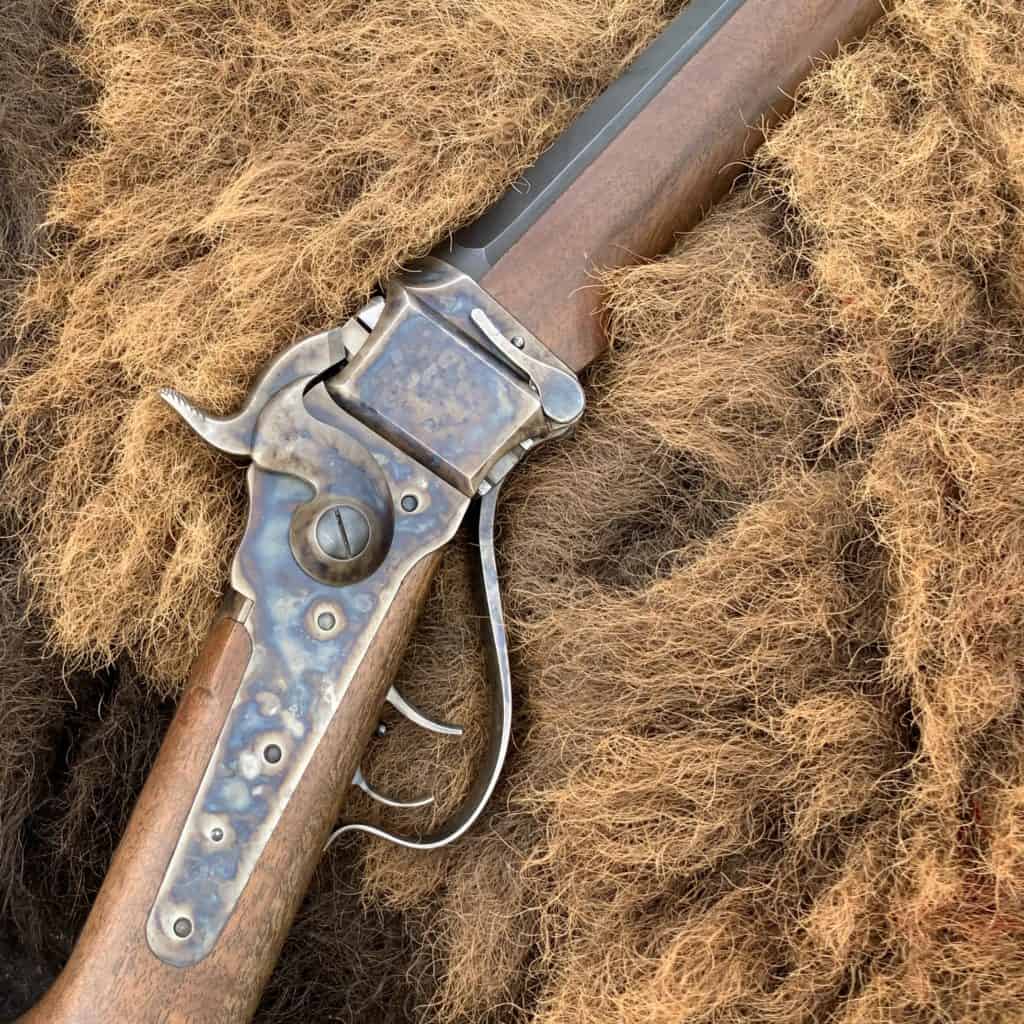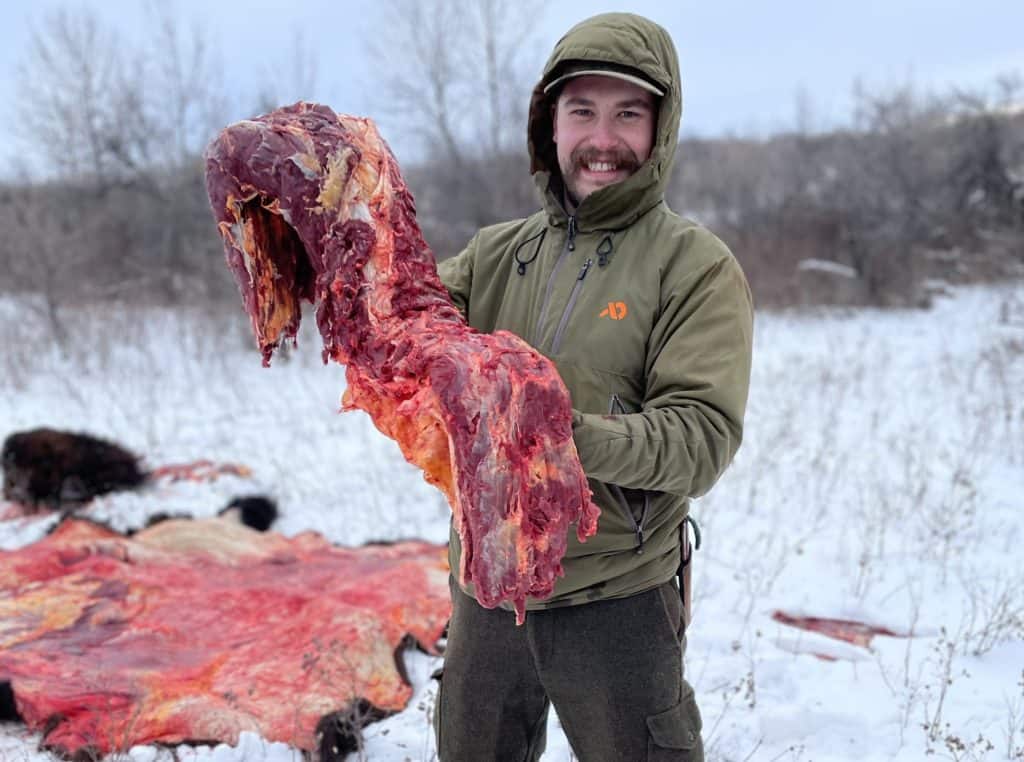
We eased our way closer and closer, trying to gain a clear shooting lane into the thick buffalo berry. With my heart going a hundred miles an hour, I slowly lowered the breech block halfway to double-check that I had loaded it. We were less than 30 yds from a herd of seven bull bison, with the most mature bull lying on his side, taking his last breaths. The last ten minutes or so have been exciting and exhausting.
This was my first time hunting the American Bison. It was something that I had always wanted to experience, and I was lucky enough for it to happen in 2021, thanks to C. Sharps Arms. As a stocker and gunsmith at C. Sharps, I was overly excited when my coworker Pat told me we were planning a company Buffalo hunt. We were heading to North Dakota to do some herd management on a 15,000+ acre ranch that had a small herd of wild bison. We drew names from a hat to decide who would be the two shooters. Morgan, a shop friend, drew one, and I was lucky enough to draw the herd bull.
Shortly after I rolled out of my sleeping bag on the top bunk, I was greeted with a hot cup of coffee, sausage, and scrambled eggs fresh off the camp stove. Good living, I thought. A quick walk outside told me that wool would be a good choice for today’s hunt. We anxiously suited up and got ready to go chase America’s largest native land mammal.
That morning when I pulled my 1874 Sharps Hartford model out of its blanket slipcover, I couldn’t help but admire the lines of the Sharps action. The rifle I would be taking on this hunt was one I had built to the specs of an original W.H. Sheard rifle that passed through the shop one day. That rifle was different than any other Sharps I had laid my hands on. It was light and balanced perfectly when I shouldered it. I took every measurement I could with hopes of building one similar someday.

When the time came to build my own, I pulled out that spec sheet, and we went to work. The 28-inch barrel was a lightweight octagon profile equipped with a semi-buckhorn sight. Chambered in 45-70, its balance point was right between the two forend screws, approximately four inches in front of the receiver, making the 8.7 lbs rifle carry exceptionally well while out hunting. The stock was laid out on a beautiful blank of Bastogne walnut, with a Hartford military-style buttstock and a “Hartford Lip” style forend. The pack-hardened receiver and lockplate are filled with colors that seem to change with the lighting.
For the cartridge, I borrowed one of Pat’s 1881 Armory bullet molds, made by Steve Brooks. The wheel-weight cast bullet weighed close to 520 gr when all was said and done. I sized the bullet to .458 and lubed it using some homemade lube out of one of Paul Matthews’s books. This bullet sat on top of 62.0 grains of FFg Elephant powder ran through a drop tube, topped with a felt wad compressed 0.120”.
We hurried forward to a clump of brush, trying to get set up where we believed the herd of 8 bulls was headed. Keeping the brush between us and where we believed the bison were going to come out, we slowly crept into position. Our shooting sticks found their place in the snow as we settled in. At this point, we were unsure what would happen, and we were hoping they were still headed this way, but there was no guarantee. Finally, someone in the group spotted the herd heading over a knoll in the opposite direction—time to reposition.

Doubt started to creep in, we were seeing bison, but would we get a shot opportunity? They were very leary of us, and if we were seen, they would no doubt high tail it in the other direction. How far would the shot be? I’m very comfortable with this semi-buckhorn sighting system out to 200 yards, but beyond that, I would much rather have one of our Deluxe Mid-range or Soule sights.
Earlier this fall, my wife and I had found ourselves in some pretty thick chokecherries less than 20 yards from a black bear. It was stripping each and every branch clean of those tart little berries. Unable to see anything but the trees moving, we still had yet to identify the bear. With grizzlies in the area, it made for a few heart-pounding minutes of anticipation.
Finally, the wind swirled, and the bear took off to our right; I ran to get to the opening 50 yards away. As I arrived, the color phase bear was entering the opening. It slowly walked across the clearing; I waited to confirm that it did not have cubs. As I identified it as being a legal bear, he started to run. My Sharps barked, and black powder smoke filled the clearing. As I hurried to where the bear was last seen, I counted my steps. 60 yards… No blood… Clean miss… The combination of it being short-range, low light, and a moving target were not ideal shooting conditions for a small aperture tang sight I had it equipped with at the time. But there is no doubt that my excitement played a much bigger role in that miss.

With that being the last hunting experience with my rifle, I was expectedly nervous going after buffalo. I have shot it hundreds of times this year and am very comfortable with it, but anything could happen, right?
We slid down the steep snow-covered embankment working into our next position. Morgan and I set up side by side, with brush behind us, breaking up our outline. We could see the bulls 600 yards away, slowly making their way in our direction. We checked our rifles and ensured we could comfortably cover the whole opening from our current positions.
As they got closer and closer, my heart started pumping, and my mind raced. I started going through my mental checks; ease the hammer back, breathe, take your time, and wait for the right shot opportunity. At about 100 yards, they were quartering to us at a slow walk; it tested my patience waiting for it to turn and present a clear shot at the vitals. At 80 yards, it turned, and I took up the slack of the front trigger on my rifle.
Read More of my Hunting Stories Here!
Steady and even pressure, I thought as the shot broke. WHOOSH! Thwack! The “Thwack” of the bullet striking the chest cavity is seemingly louder than the shot itself. I hear “good hit” from a coworker 10 yards behind me. I ejected the empty cartridge and loaded the one I had strategically positioned between the fingers of my left hand. Breathe… WHOOSH! Thwack! “Good Hit” I hear again. To try and reduce unnecessary suffering, I asked Morgan to put one into him as I fumbled with getting a cartridge out of my leather belt pouch. He made a good hit, and I put two more into him as he showed no reaction to the five 520 gr bullets and made his way out of sight.
I pulled up my binoculars and identified the second one as another bull in the age class we were after. Morgan’s 1874 Bridgeport bellowed. Good hit. He got one more into him before they herded up, making it near impossible to make a shot without risking hitting another one. They made their way around the ridge we had just come down, and we lost sight of them.
As we headed around the ridge, Morgan’s bull took its last steps. They split off and started processing it while we kept moving forward, trying to locate my bull. It wasn’t long before we could see the dark figures in the thick buffalo berry brush. With nerves at an all-time high, the last bull finally left the carcass, taking off in the opposite direction of us.

Walking up to such a magnificent animal is something that can’t be accurately described in text, as there is no way to represent the experience properly. Weighing an estimated 1700-1900 lbs, this old warrior’s horns were double-broomed, and the sides of his belly were scarred from years of fighting. Immediately you are hit with realizing the seemingly insurmountable amount of work that lay ahead.
Later, while skinning each bull, we found all five of the shots placed perfectly in the lungs, once again showing the toughness of these animals. We found the bullets only slightly mushroomed on the opposite side of the hide, some having penetrated almost 40 inches. Morgan had the same luck finding his bullets on the opposite side of the hide.
A few days later, we found ourselves at home in Montana with hundreds and hundreds of pounds of the best meat on earth. Pat and his dad showed me the ropes of butchering as we spent the next two days processing quarters into steaks and burgers. I can’t thank Pat enough for organizing the hunt and doing all the leg work. Unfortunately, he got sick right before and was unable to attend.

I’ve always been fascinated by and have read countless books on American Bison. I am still trying to process what happened that day. One can’t help but look at what an unbelievable feat it is to have these large animals back on the landscape across the country in huntable populations. While they will never be at the levels they once were, they have made a comeback and are here to stay nonetheless.

Written by: Kurt Martonik
Kurt is a Gunsmith, Reloader, Hunter, and Outdoorsman. He grew up in Elk County, Pennsylvania, where he became obsessed with the world of firearms. Following high school, Kurt enlisted in the United States Air Force as a Boom Operator, where he eventually rose to the position of Instructor. After his military service, he attended the Colorado School of Trades(CST) in Lakewood, CO for gunsmithing. Following graduation, he accepted a job at C. Sharps Arms in Montana, where he worked as a full time stockmaker and gunsmith.
Note: Most of the links in this article earn me a small commission at no cost to you. If you use these links, it helps me continue to put out free content for viewers. Thank you for the support!